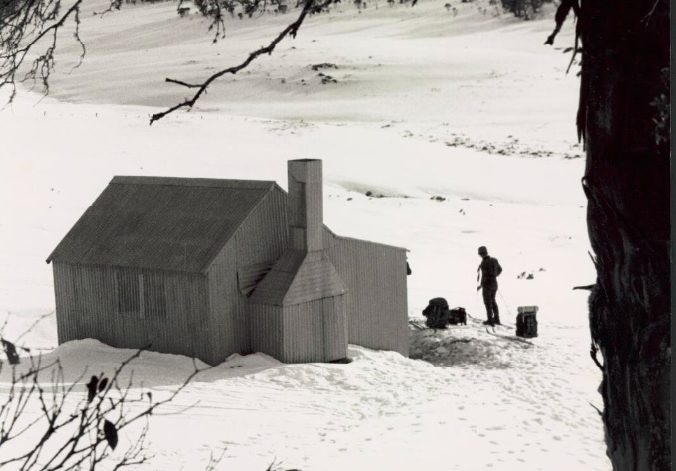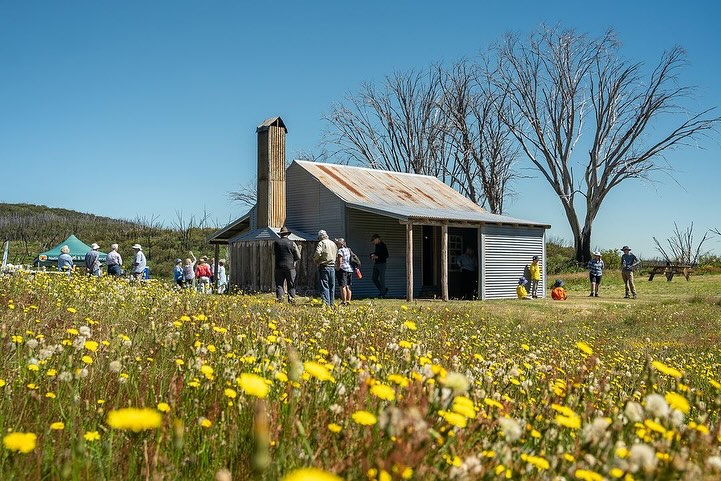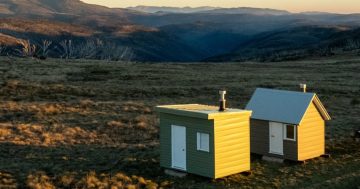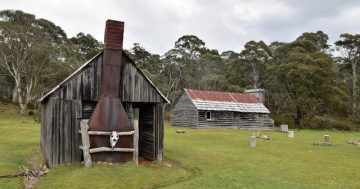
Brooks Hut on the Happy Jacks Plain in the 1970s. Photo: Klaus Hueneke/Kosciuszko Huts Association Photograph Collection.
When Bill and Cliff Brooks built a stockman’s mountain hut overlooking Happy Jacks Plain, west of Eucumbene Dam, in 1945, they had no way of knowing it would have three lives.
Yet, just last month, what once stood on a grazing lease was granted another lease on life, thanks to volunteers, family members, caretakers, the Kosciuszko Huts Association and the National Parks and Wildlife Service (NPWS) staff, whose combined efforts are ensuring the historic huts of the Snowy Mountains rise phoenix-like from the 2019-2020 Black Summer bushfires.
Brooks Hut hasn’t had a lot of luck. But what has been on its (under)side is the Brooks brothers’ judicious use of stones as foundations, infusing the small corrugated structure with longevity that would survive the brutal powers of nature, which battered it for 58 years.
Those rocks may have saved the timber floors from damp ruin long after grazing leases were revoked and the last cattle and sheep had been mustered from the mountains, but it would be a bushfire in the summer of 2003 that would finally bring Brooks Hut down, alongside 47 other heritage huts scattered across the Australian Alps.
Long used as a spot for a breather for summer trekkers and, in winter, refuge to hardy cross-country skiers, the hut had been reduced to an iron mess likely never to rise again.
But a determined Kosciuszko Huts Association prevailed against the anti-hut movement of that time, and five years later Brooks Hut was back, its 8 x 4.5-metre footprint (with verandah) celebrated at its official reopening in 2009.
With a roof and walls constructed of corrugated iron, the small one-window structure had at its heart a substantial fireplace with concrete hearth, perfect for imperilled skiers who would arrive to find – thanks to the Hut Code – matches, kindling and wood to stave off the cold.
Then came the January 2020 fires, when Brooks Hut was, again, significantly damaged, its chimney the only remnant standing.
But four years on – on the first weekend of February – it again shone under the admiring eyes of everybody and anybody who had a hand in its latest rebuild, painstakingly restored to its former glory; a simple shepherd’s hut.
The 200 historic huts of the Australian Alps, some dating from the 1860s, come from every era of European history in the region, built for simple shelter by graziers, gold miners, foresters, government workers, skiers and bushwalkers.
They stand today as a monument to that heritage, attracting international visitors to the region, acting regularly as a backdrop to family reunion photos and resting bushwalkers.

Bradley and O’Brien’s Hut was also reopened last month. Photo: Kosciuszko Huts Association/Facebook.
The rebuild of Bradley and O’Brien’s Hut, south of Cabramurra along Tooma Road, also officially opened on 3-4 February, means four of 10 huts destroyed in the 2020 bushfires have now been reconstructed, with the remaining rebuild efforts to be carried out by 2026.
It was built in 1952 by Jack Bailey with help from the Bradley and O’Brien families before Tooma Road was developed.
It was originally used as a base for High Country grazing, but the stables and horse yards were removed by the NPWS and the area around the hut is commonly used by campers planning to head off to the Jagungal wilderness and winter’s cross-country ski contingent.
Destroyed in the January 2020 bushfires, the 6.5 m x 4 m homestead-style hut, with verandah, is timber-framed with corrugated iron walls and roof.
The floor consists of sawn timber, and a solid fireplace is set on a concrete slab.
Another hut near completion is Four Mile near Kiandra. Originally built by Robert Hughes in 1937, it too was destroyed in the 2019-2020 bushfires.
According to the Kosciuszko Huts Association, over the past few months the NPWS and volunteers, including those from the NSW Nordic Ski Club, have been working hard on the rebuild, with a reopening expected later this year.










